Alex Ovechkin and the Washington Capitals have finally done it.
For the first time since 1998—and after years of frustration, anguish, and disappointment—the Capitals are headed to the Stanley Cup Final to take on the Vegas Golden Knights, who, of course, have their own unique story to add to hockey lore.
Though it has its own idiosyncrasies, Washington’s tale, however, has already been written.
Many would agree: history repeats itself. It’s a sentiment that was true for previous underperforming Capitals teams. And it’s certainly the case for the 2018 Capitals in terms of how they reached the Stanley Cup Final. They’ve followed the same path as the 1997 Detroit Red Wings, with more than a few parallels connecting the two extraordinary teams.
Related – 1996-97 Red Wings: Where Are They Now?
Draft the Savior
After years of mediocrity, the Red Wings and Capitals both had the opportunity to draft a franchise savior capable of leading their team to glory. For Detroit, that player was Steve Yzerman, the fourth overall selection in 1983. And for the Capitals, they drafted Alex Ovechkin 21 years later in 2004 with the first overall pick.
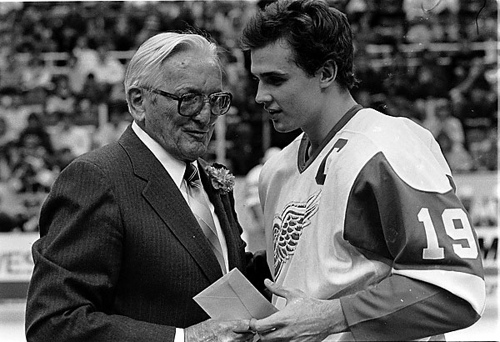
These selections represented a turning point for both franchises. With the arrivals of Yzerman and Ovechkin, new eras were ushered in. These were the kind of players who you could build around and trust with the future of the organization. Best of all, these players were supposed to revitalize the fan base and bring in a whole new generation of fans.
Upon arriving at training camp, both instantly became the best players on the ice for their respective teams. And in time, the two organizations would surround their superstars with complementary players—such as Gerard Gallant and Sergei Fedorov in Detroit, and Nicklas Backstrom and Evgeny Kuznetsov in Washington—to help them take the next step. Team progress, however, would take time to establish.
Related: Cup Final for the Capitals, Finally
Years of Disappointment
Success did not happen overnight. Both the Red Wings and Capitals had to endure growing pains as they learned how to win.
Coaches came and went as the organizations searched for the right voice to lead their team. The Red Wings were guided by Nick Polano, Harry Neale, Jacques Demers, and Bryan Murray before finally finding the right coach: Scotty Bowman. It was Bowman who transformed Yzerman into a two-way player after years of offensive domination but a lack of defensive awareness. Yzerman’s commitment to defense served as an example to his teammates, who soon following suit.
The Capitals employed a number of coaches as well before finally finding someone who could break through. Glen Hanlon, Bruce Boudreau, Dale Hunter, and Adam Oates each had different philosophies on how to compete, but none of the four could turn Washington into a Cup-contender. Barry Trotz may not be Scotty Bowman, but he discovered the ideal approach to coaching Ovechkin and the Capitals. It was also under Trotz’s tutelage when Ovechkin finally became a responsible and effective player in his own end.
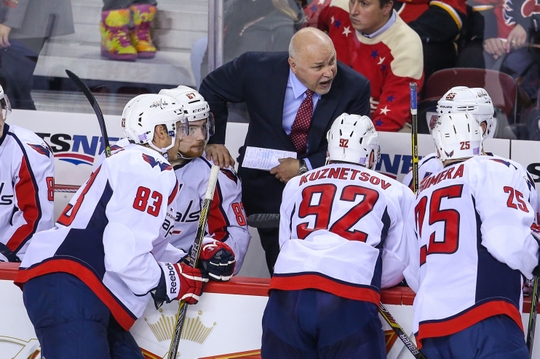
When the teams were able to attain some levels of regular season success, the postseason was a harsh reminder that the Red Wings and Capitals still had work to do. Optimism was quickly met with first- and second-round exits. Each year concluded with the same sentiment: there was more to give, but no more games to play.
Disappointed, the Red Wings and Capitals ended their seasons early. For fans and media, “next year” became the motto.
Related: Fuzzy History of the NHL Playoff Beard
Expectations & Bitter Rivals
There was a point, however, when “next year” turned into “this year.”
1995 & 1996 Red Wings
Through savvy trades, free agency, and years of quality drafting, the Red Wings and Capitals became true contenders. For the Red Wings, that first year was the lockout-shortened 1994-95 season. Bowman and general manager Jim Devellano had finally put together an unstoppable team capable of bringing the Stanley Cup back to Hockeytown. Paul Coffey, Dino Ciccarelli, Sergei Fedorov, Vladimir Konstantinov, Slava Kozlov, Nicklas Lidstrom, Ray Sheppard, and Mike Vernon helped Yzerman dominate during the regular season and cruise through the playoffs. This was “the year.”
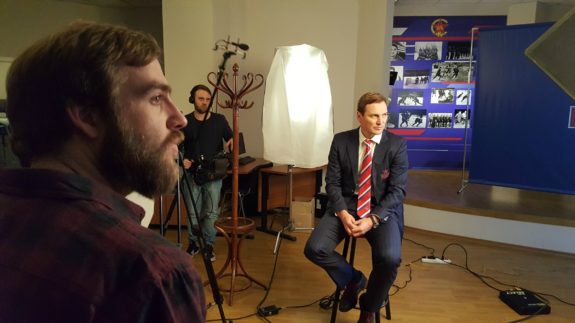
The New Jersey Devils had different plans, though. They quickly swept the Red Wings in the Stanley Cup Final, suffocating Detroit’s potent offense. Heartbreak ensued and more offseason tinkering followed.
Determined to redeem themselves, the Red Wings took the league by storm during the 1995-96 season, producing an unfathomable 62-win campaign with Yzerman recording his 500th career goal and Bowman assembling the Russian Five along the way. From top to bottom, the Red Wings were unstoppable.
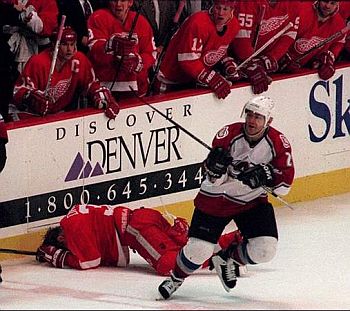
After their incredible regular season, everyone thought it was finally, truly the Red Wings’ year. Detroit dispatched two quality teams—Winnipeg and St. Louis—before meeting the Colorado Avalanche in the Western Conference Final. It was a grueling, physical series, but the Avalanche came out on top. Detroit was left with more disappointment, a broken face, and the agony of watching a bitter rival take home what was supposed to be their Stanley Cup.
The team was at a crossroads.
2016 & 2017 Capitals
After yet another disappointing second-round loss in 2015, the Capitals loaded up during the offseason by acquiring potent goal scorer T.J. Oshie from St. Louis and signing “Mr. Game 7” himself, Justin Williams. Like the Red Wings before them, Washington dominated opponents during the regular season en route to the Presidents’ Trophy, which was won with ease – second-place Dallas trailed Washington by 11 points at season’s end. Ovechkin celebrated a personal milestone, with his 500th career NHL goal, joining Yzerman a select few to accomplish that feat with one franchise.
After knocking off the Philadelphia Flyers, the Capitals drew their arch-rival—the Pittsburgh Penguins—in the second round. Washington’s league-leading offense could not solve Penguins rookie netminder Matt Murray, and Pittsburgh moved on and eventually won the 2016 Stanley Cup while the Capitals watched from home.
However, this Capitals team was not done. Their window was still open, as a handful of their key players still had one more year left on their contracts, including Karl Alzner, Oshie, Williams, and Daniel Winnik, plus a few restricted free agents due for a raise the following summer. Next year—the 2016-17 season—was going to be the Capitals’ year. No need to rebuild just yet.
Washington took no prisoners during the regular season, only finishing two points back from the previous year and once again claiming the Presidents’ Trophy with the league’s best record. To add to their monstrous power play and overall high-octane offense, the Capitals acquired slick blueliner Kevin Shattenkirk at the 2017 NHL trade deadline. Shattenkirk instantly took over the first power-play unit and produced 14 points in 19 games after the deadline. The team, with depth from top to bottom, was “all in” and ready to capture its first Stanley Cup.
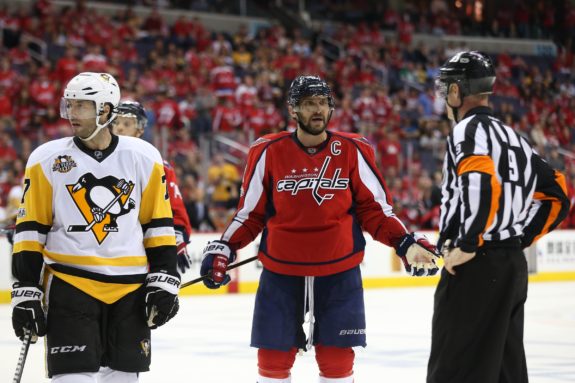
In D.C.’s opening series, the Capitals defeated the young, upstart Toronto Maple Leafs. Waiting for Washington in the next round—you guessed it—were the Pittsburgh Penguins. But this year was going to be different. This year was going to be the Caps’ year.
The start of the second round said otherwise. After Pittsburgh took a 3-1 series lead, it looked like more disappointment for the Capitals. But Washington would not back down. The Caps scored three third period goals to avoid elimination in Game 5 and trounced Pittsburgh in Game 6, setting up the pivotal Game 7 in the nation’s capital. All eyes were on the Capitals to complete the comeback.
Instead, Pittsburgh flexed its Stanley Cup champion muscles and completely suffocated Ovechkin and Washington’s offense. Marc-Andre Fleury only needed to stop 29 shots to defeat the Capitals. Once again, the Caps watched as their bitter rival advanced, dejected from being so close from lifting a huge monkey off their back.
Calls to Trade the Captain
What happens when a team destined for the Stanley Cup falls short of their goal? Change is proposed. Drastic change.
After the Red Wings failed to turn a 62-win season into a Stanley Cup, management began to wonder if Yzerman was the right player to lead the team. He was in his early 30s and on the decline. Should the team move on from the veteran captain and trade him while his value is still relatively high?
It almost happened. It’s true; the Red Wings nearly dealt Yzerman to Ottawa for Alexei Yashin. Decade-old frustrations came close to sending Yzerman to his hometown Ottawa Senators.
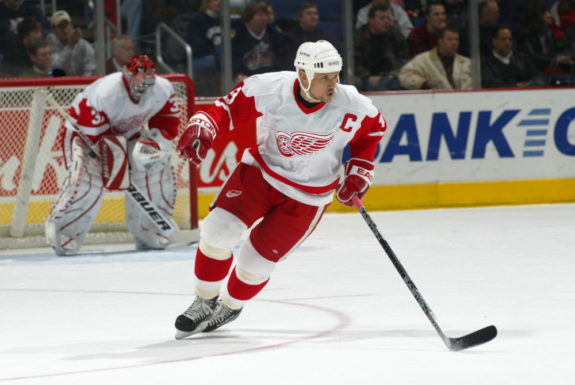
Ovechkin faced a similar circumstance, though no trade proposals ever came to light. Media—including the capital’s own Washington Post—and fans questioned whether Ovechkin was capable of delivering D.C. a championship one day. His inflated contract and declining numbers certainly contributed to the notion that the Capitals should entertain an Ovechkin jettison before their long-time captain regressed further and lost trade value.
Luckily, for both franchises, no deals took place. Their captains remained just that.
Younger, Faster, Stronger
Instead of dealing Yzerman, the Red Wings made changes elsewhere prior to the 1996-97 season, with the emphasis on getting stronger and younger. The premier acquisition was Brendan Shanahan, who the Red Wings received from Hartford in exchange for Paul Coffey, Keith Primeau, and a first-round pick.
Apart from bringing in a soon-to-be fan-favorite in Shanahan, Detroit made a handful of minor moves. Marc Bergevin, Dino Ciccarelli, Stu Grimson, and Mike Ramsey were all let go during the offseason or early the next year. In their place, the Red Wings brought in young players to fill the void. Mathieu Dandenault, Tomas Holmstrom, and Jamie Pushor became regulars. Martin Lapointe, Kirk Maltby, Darren McCarty, and Aaron Ward all played larger roles than the year before.
Related: Detroit Red Wings: How The Grind Line Revolutionized the NHL
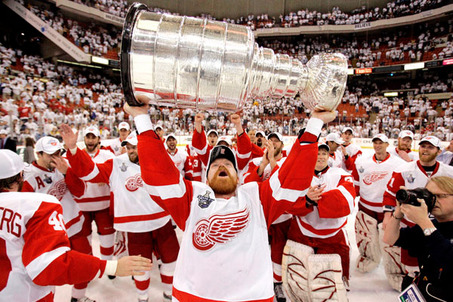
The 1996-97 Red Wings no longer solely focused on finesse, but instead outworked and outmuscled opponents night after night. Surely, Yzerman, Shanahan, and the Russian Five provided highlight-reel offense – the team just had more layers to it.
This past offseason, the Capitals followed a similar route. Instead of locking up aging veterans for one more Stanley Cup push, they waved goodbye to the likes of Alzner, Shattenkirk, Williams, and Winnik. In addition, Nate Schmidt was claimed by the Vegas Golden Knights in the expansion draft and Marcus Johansson was dealt to the Devils.
To replace these players, Washington went younger, faster, and more physical with their approach. Devante Smith-Pelly and Alex Chiasson were signed as free agents. Madison Bowey, Christian Djoos, Chandler Stephenson, Jakub Vrana, and Tom Wilson were all given larger roles.
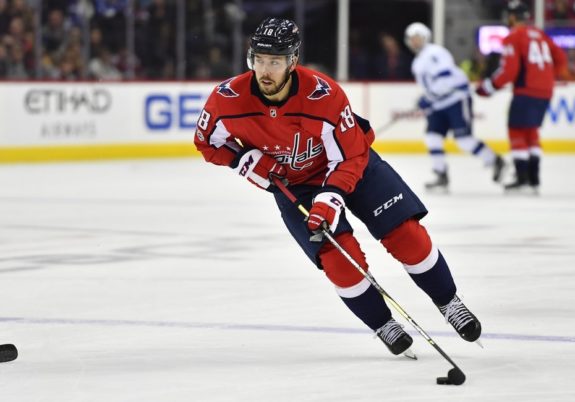
After Pittsburgh beat the Capitals with speed, strong forechecking, and timely scoring, Washington sought to fight fire with fire – just as how the Red Wings addressed their weaknesses two decades prior, after they were exposed by the Avalanche.
No Longer the Favorite
For the 1996-97 Red Wings and 2017-18 Capitals, the two teams entered the postseason well-off in the standings, but not the favorites by any means. Detroit finished third in the Western Conference and Washington tied for third in the overall Eastern Conference standings.
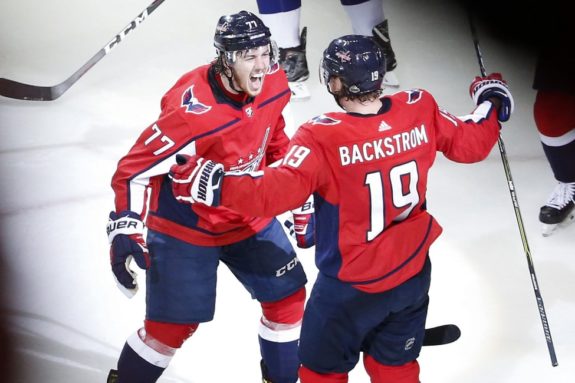
Neither team was the popular pick to take home the Stanley Cup. In 1997, the talk was about Colorado, Dallas, or Anaheim possibly coming out of the west. This year, Tampa Bay, Pittsburgh, and even Boston were the go-to choices for the east.
Perhaps the focus—and pressure—was off Detroit and Washington as a result. Maybe it put a chip on their shoulder. Either way, the two teams thrived as the underdogs throughout their respective postseasons.
Rival Standing in the Way of Glory
To advance in the playoffs, both the Red Wings and Capitals had to go through their rivals. Colorado and Pittsburgh, respectively, stood in their way.
That’s just how the story goes, though. To exorcise your demons, you must go through what previously stopped you. Redemption is much sweeter that way – by confronting your past, you can determine your future. And that’s just what Detroit and Washington accomplished.
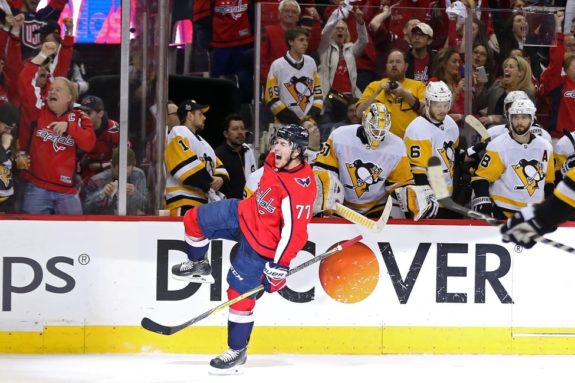
In a back-and-forth series consisting of two of the NHL’s best, the Red Wings knocked off the Avalanche in six games, with a 3-1 victory at home. The sold-out Hockeytown crowd witnessed their hometown heroes redeem themselves after a heartbreaking defeat the prior season.
Related: Detroit Red Wings: Top 5 Most Iconic Moments at Joe Louis Arena
For the Capitals, a third matchup in three years with the Penguins separated them from advancing to the Eastern Conference Final for the first time since 1998. After four games, the series stood even, but the Capitals were able to take Game 5 at home with a chance to claim the series on the road. However, they would have to do so without Nicklas Backstrom, Andre Burakovsky, and Tom Wilson in the lineup.
With a handful of black aces penciled in for Game 6, Washington surprised many with a 2-1 overtime victory in Pittsburgh, with Evgeny Kuznetsov’s breakaway tally—and subsequent bald eagle celebration—ending the series.
It's been 20 years! #ALLCAPS fans rejoice you're on to the third round! #ALLCAPS 2 – 1 (OT) #3elieve
Kuznetsov WHAT. A. GOAL.#StanleyCup pic.twitter.com/uyKGYNb6WN
— SiriusXM NHL Network Radio (@SiriusXMNHL) May 8, 2018
Fourteen Years Later
Almost a decade-and-a-half after their franchise saviors—Yzerman and Ovechkin—had been drafted, both the Red Wings and Capitals reached new heights. Detroit went on to win the 1997 Stanley Cup, thanks to a four-game sweep of the heavily-favored Philadelphia Flyers. For Yzerman and the city of Detroit, the victory ended a long, long stretch of frustration.
After defeating the Penguins, Ovechkin’s Capitals beat the Tampa Bay Lightning in seven games to advance to the Stanley Cup Final – Ovechkin’s first trip to the ultimate stage. In fact, the second-round Penguins series victory was the furthest Ovechkin had advanced in his entire career.
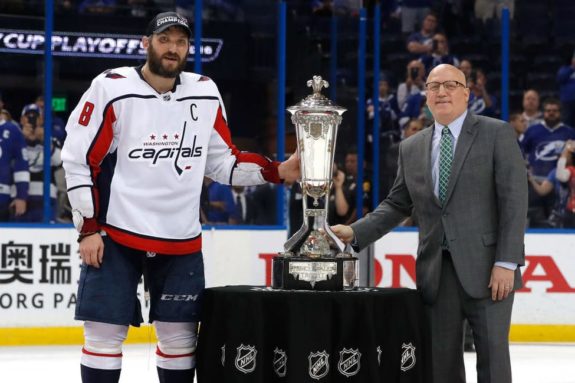
Both captains led the way to these lofty stages, despite years of criticism, bad luck, and deflating losses in the back of their minds. Sheer determination and otherworldly play at both ends of the rink earned Yzerman and Ovechkin a chance to take home the Stanley Cup.
Related: The 600-Goal Club
For today’s Capitals, they have the opportunity to follow in Detroit’s footsteps and bring the Cup to Washington. It had been 42 years since the Red Wings had last won the Stanley Cup. This was Washington’s 44th year in the NHL – with no championships to their name. One more series victory would change that.
And, for the Red Wings, their run did not end there. In fact, they had quite a prosperous next decade, with three additional championship banners raised in Detroit. Perhaps Washington is due for that same fate.
For more on the 1997 Detroit Red Wings, check out their championship video, which chronicled their season and history leading up to the victory: